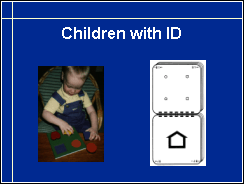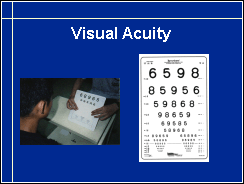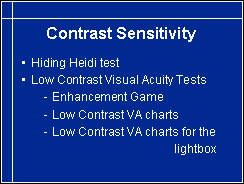4. Visual Acuity and Contrast Sensitivity
Single optotypes are the first visual acuity test in testing young children and children with developmental delays. When the child can place a puzzle piece on a corresponding picture, visual acuity can be measured by using smaller and smaller pictures. The child may also use names for the forms or corresponding signs. Even if playing with puzzle pieces is typical to young children, many children with communication difficulties choose that mode of responding still at school age. It apparently gives the test situation an atmosphere of a game.

Line test is the standard test of visual acuity. Testing at near is often possible earlier than at greater distances but keeping the test distance is more difficult than in distance testing. It is therefore, the cord has been included in the near vision test. In case of brain damage related visual impairment line test acuity may be several lines less than visual acuity measured with single symbols.

More crowded tests at near reveal the size of texts that can be used in learning to read. In cases of brain damage related vision impairment, visual acuity measured with these tests may be a few lines less than the values measured with the line test.
Crowding is a diagnostically important feature in vision tests. In single symbol tests optotypes are far from each other, thus there is no interfering visual information around the optotypes. They are easy to see even if fixation is unstable and focusing not quite sharp. When the same optotypes are in a line test, the space between them is equal to the width of the optotypes, which makes fixation more demanding. In the more crowded tests on the backside of the near vision test the distance between the optotypes is again increased.
Even a normally sighted child has kower visual acuity value in the most crowded tests than in the single symbol test but the difference is only 1-2 lines at 6-7 years of age. If a child is found to have "increased crowding effect" it means that there is a greater than normal drop in the visual acuity values when the distance between the optotypes decreases. It is usually a sign of changes in the posterior visual pathways or in oculomotor functions or both.

Children with intellectual disability are often assessed using single symbol book. It should be explained to the parents, teachers and therapists that visual acuity may not be correctly depicted by this test.

Older children are examined using number optotypes at distance and at near.

Video
Observations during near vision tasks are an important part of all assessment. Working distance, type of pen/pencil, eye-hand coordination, technique and quality of drawing/writing, duration of active working, all these different aspects of working give insight into the child's capabilities and need of special education. This boy is the infant with dual sensory impairment in slide number 23.

Contrast sensitivity is measured either using low contrast optotype tests or low contrast gratings. The earliest measurements are possible with the Hiding Heidi pictures that can be used at the age of a few weeks. Optotype tests become possible at the same age as testing with visual acuity tests at high contrast. Sometimes the 10M-size optotypes at low contrast interest a two year old more than the tiny optotypes at high contrast. Contrast sensitivity measurements are influenced by the luminance level on the test. Therefore testing contrast sensitivity as a part of follow-up should use tests on lightbox where luminance level is constant.
